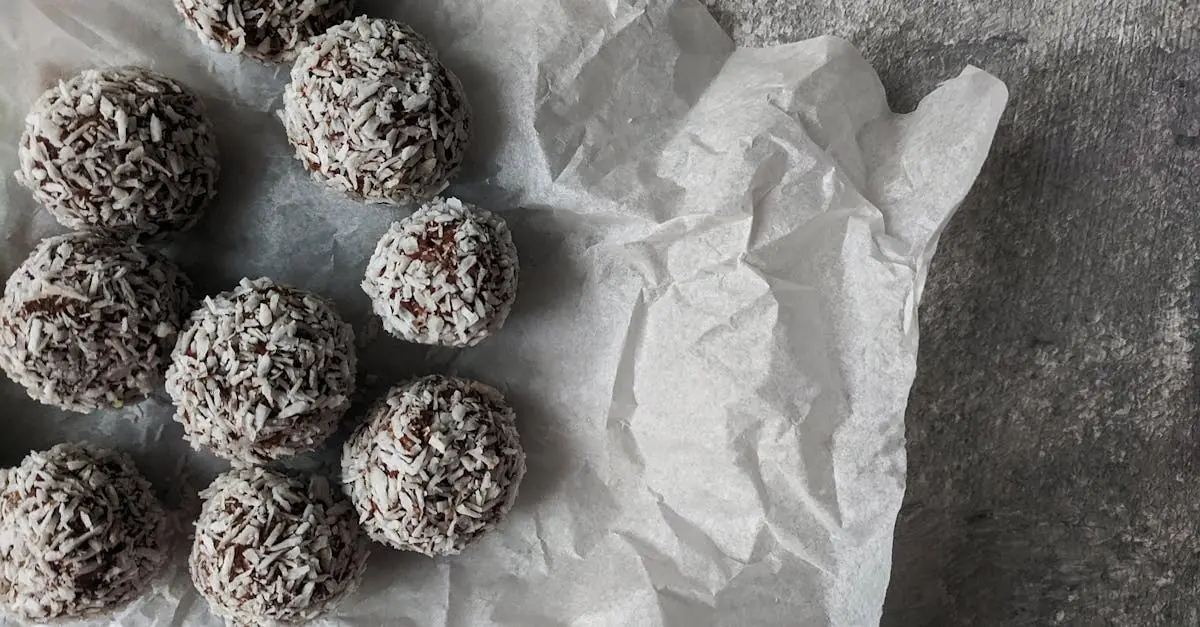Imagine a cooking method that wraps your ingredients in a cozy, paper hug while sealing in flavors and moisture. Enter parchment cooking—a technique that’s as simple as folding a piece of paper and as satisfying as finding a hidden stash of chocolate. Whether you’re a culinary novice or a seasoned chef, this method transforms ordinary meals into extraordinary experiences.
Parchment cooking isn’t just about convenience; it’s a secret weapon for healthier meals too. By using minimal oil, it helps keep calories in check while maximizing taste. Plus, who wouldn’t want to impress dinner guests with a steamy, aromatic parcel that bursts open at the table? Get ready to unleash your inner gourmet while keeping things fun and fuss-free.
Table of Contents
ToggleOverview of Parchment Cooking Method
Parchment cooking involves wrapping food in parchment paper to create an enclosed environment for steaming. This technique preserves moisture while intensifying flavors through gentle cooking, often referred to as en papillote, which translates to “in paper” in French. By using this method, cooks minimize the need for additional fat, leading to healthier meal options that still deliver rich taste.
Ingredients such as fish, vegetables, and poultry excel with parchment cooking. The method allows for varied flavors through the addition of herbs, spices, and citrus. Ingredients cook evenly, making this technique perfect for preparing multiple portions at once, offering both efficiency and flavor.
Chefs often enjoy the visual aspect of plated parchment parcels. Presentation elevates the dining experience, appealing directly to guests’ senses. Moreover, the aroma released upon opening the parchment enhances the dish’s allure and sets an inviting tone at the table.
Minimal cleanup is another advantage of this cooking method. With parchment lined on the baking sheet or dish, time spent on washing dishes significantly decreases. This ease of use encourages experimentation, allowing cooks to try new combinations of ingredients and flavors without the fear of complicated cleanup.
Incorporating parchment cooking into meal preparation not only simplifies processes but also introduces a variety of culinary experiences. Successful outcomes depend on correct folding and sealing techniques to retain steam. By following these methods, one can achieve consistently flavorful dishes that impress with both taste and presentation.
Benefits of Parchment Cooking
Parchment cooking boasts several advantages that enhance both health and flavor. This method has gained popularity for its positive impact on meal preparation.
Health Advantages
Parchment cooking significantly reduces the need for added fats. Minimal oil usage leads to healthier meals and lower calorie counts. Ingredients retain their natural nutrients due to steam trapped within the parchment. Studies show that steaming vegetables can preserve up to 90% of vitamins, making this method beneficial for nutrient-rich meals. It also accommodates various dietary preferences, such as gluten-free or low-carb options, supporting diverse eating habits. This technique allows individuals to explore nutritious ingredient combinations while maintaining flavor.
Flavor Enhancement
Parchment cooking intensifies natural flavors through effective steaming. Aromatic herbs and spices infuse dishes, elevating taste without excessive seasoning. Ingredients cook evenly, so diners enjoy consistent flavor in every bite. The enclosed environment captures moisture and aromas, creating a delightful unwrapping experience at the table. Citrus juices or wine can be integrated easily, adding brightness to the dish. This method creates a harmonious blend of flavors, appealing to all palates. Experiments with different ingredients continuously yield outstanding results, securing parchment cooking’s place in culinary practices.
Techniques for Parchment Cooking
Parchment cooking involves specific techniques that enhance its effectiveness. Mastering these techniques greatly influences taste and presentation.
Preparing Ingredients
Begin by selecting fresh, high-quality ingredients. Fish, vegetables, and poultry work well in this method. Portion the ingredients evenly, ensuring they cook uniformly. Use aromatic herbs, zesty citrus, and spices to elevate flavors naturally. He emphasizes cutting vegetables into similar sizes for even cooking. Drizzling a touch of oil can add richness while maintaining health benefits. Incorporating ingredients with various textures creates an engaging dish. For instance, combining firm vegetables with tender fish showcases delicious contrasts in each bite.
Folding and Sealing the Parchment
Effective folding and sealing guarantee optimal steaming. First, cut a large piece of parchment into a heart shape. Create a crease down the center to serve as a guide. Place the prepared ingredients on one half, avoiding overcrowding. Then, fold the other half over the ingredients. Seal the edges tightly by folding them over several times. This step prevents steam from escaping during cooking. Some may choose to create decorative shapes or twists to enhance presentation. Proper sealing retains moisture and intensifies flavors, resulting in an impressive dining experience. Each package opens to reveal beautifully cooked meals with aromatic steam.
Tips for Successful Parchment Cooking
Select high-quality ingredients to enhance flavor and ensure freshness. Portioning ingredients evenly contributes to uniform cooking, so keep sizes consistent for optimal results. Incorporate aromatic herbs, zesty citrus, and spices to elevate taste without adding excessive seasoning.
Use a touch of oil for added richness while still maintaining health benefits. Combining ingredients with different textures creates an engaging culinary experience, making the dish more appealing. Cut vegetables into similar sizes to promote even cooking, ensuring all components reach the correct doneness.
Effective folding and sealing techniques play a crucial role in parchment cooking. Cut parchment paper into a heart shape and create a crease for guidance during the folding process. Seal edges tightly to prevent steam from escaping, as this retains moisture and intensifies flavors.
Bake the parchment packets on a baking sheet to catch any drips and facilitate even heat distribution. Avoid overcrowding the packets, since this may hinder steam circulation and cooking efficiency. Monitor cooking times closely to achieve the desired results, adjusting as needed based on ingredient types and sizes.
Consider experimenting with different herbs and spices for a diverse flavor profile. Try using seasonal ingredients for variation and freshness. Explore unique combinations to surprise guests with aromatic and visually appealing meals, enhancing the overall dining experience.
Serve dishes directly in their parchment packets for a stunning presentation. This method creates an inviting aroma that adds excitement when unwrapping parcels at the table. Enjoy the simplicity of cleanup by discarding parchment paper, which encourages further experimentation and enjoyment in the kitchen.
Common Recipes Using Parchment Cooking Method
Parchment cooking suits a variety of recipes, showcasing its versatility. Fish en papillote stands as a classic example, where fillets like salmon or cod cook beautifully in their steam. Season fish fillets with citrus slices, herbs like dill or parsley, and a sprinkle of salt, resulting in a moist and flavorful dish.
Vegetable medleys also shine in parchment. Combine seasonal vegetables such as zucchini, bell peppers, and carrots, along with olive oil and fresh herbs. This method enhances their natural sweetness while preserving essential nutrients through effective steaming.
Chicken breasts benefit greatly from this technique. Place seasoned chicken alongside sliced onions, garlic, and cherry tomatoes in parchment. The steam tenderizes the chicken and melds the flavors, producing a delicious meal with minimal effort.
For a hearty meal, try parchment-baked quinoa. Mix cooked quinoa with diced vegetables, broth, and spices. The ingredients cook evenly, infusing one another with rich flavors while maintaining moisture.
Desserts find a unique home in parchment as well. Parchment-baked fruits, like apples or pears, create a warm, aromatic treat. Sprinkle fruits with cinnamon and a drizzle of honey before enclosing them tightly. The result is a sweet, fragrant dessert that impresses.
These recipes highlight the charm of parchment cooking. It creates meals that taste exceptional while promoting healthier eating habits. Enjoy experimenting with different ingredient combinations to discover new and exciting flavor profiles.
Parchment cooking stands out as a versatile and health-conscious method that transforms the way meals are prepared and enjoyed. Its ability to lock in moisture and enhance flavors makes it a favorite among home cooks and culinary enthusiasts alike. The technique not only simplifies meal prep but also invites creativity in ingredient selection and presentation.
With minimal cleanup and the opportunity to explore diverse flavor combinations, parchment cooking encourages a delightful culinary adventure. Whether it’s a weeknight dinner or a special gathering, this method promises both impressive results and a memorable dining experience. Embracing parchment cooking can elevate any meal while promoting healthier eating habits.




